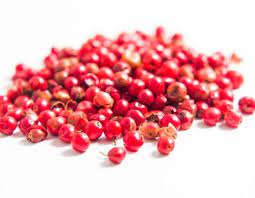Red pepper differs from other types of pepper not only in color. Here you will find all the important information about the spice.
Along with salt, pepper is one of the most important spices in every kitchen. It gives the food a spicy note and rounds off the taste. But pepper is not just pepper: A distinction is made between green, black, white and red varieties. The red pepper plays a special role in the kitchen – because the variety is very rare.
storage and use
Basically, you can use red pepper like any other type of pepper. But note:
You should not grind the red peppercorns in the conventional pepper mill. The grains are very soft – it is better to sprinkle them over the dish. Alternatively, you can gently crush the red pepper in a mortar and pestle before seasoning the food with it.
It is best to sprinkle your dishes at the end of the cooking time to preserve the full flavor of the peppercorns.
Due to its particularly intensive pepper aroma and its spiciness, the red pepper is particularly suitable for seasoning:
spicy sauces
vegetables
salads
Pan-fried meat (such as fillets and steaks; for the sake of the environment, however, the following applies to meat: less is more, and if so, then in organic quality)
Fish (but beware: most types of fish are overfished and therefore not recommended)
Because of its sweet note, red pepper is also suitable for refining desserts or chocolate – especially in combination with fruit.
In addition to its taste benefits, the red pepper can also score points visually. Due to their deep red colour, the peppercorns are very attractive and are ideal as a table decoration or topping for special dishes.
Tip: Red pepper can be stored for up to two years. However, you should store it in a dark and cool place and pack it as airtight as possible.
Red pepper: That’s what makes it so special
Taste: The red pepper is characterized above all by its special taste: During the long ripening period, a lot of sugar can be stored in the pepper fruit. As a result, the peppercorns not only taste hot, but also slightly sweet.
Ingredients: Red pepper also contains numerous vitamins: it is particularly rich in vitamins A, C and B6. It also contains minerals such as magnesium, calcium and iron. This makes red pepper a particularly healthy spice.
Traditionally, pepper was also used as a medicinal plant in India, as it is said to have the following effects. It is said to…:
Relieve upset stomach and sore throat
help against rashes and inflamed wounds
relieve itching
and help with weight loss.
Rarity: The sun gives the peppercorns their deep red colour. For this, however, the red pepper has to mature for a long time. In addition, field workers have to harvest it by hand.
These factors make red pepper unattractive to farmers. They tend to opt for green or black pepper, which can be harvested quickly. That is why the red pepper is very rare – and more expensive than the conventional varieties. You can find it in delicatessen shops, among other places.
Production of red pepper
Red pepper does not grow on a special pepper plant. All the different varieties come from the same plant: the so-called pepper bush is a climbing plant that originally comes from India. From there, pepper cultivation spread across Southeast Asia to Indonesia and Malaysia. Today, the main growing areas for pepper are in Vietnam, India, Brazil, Malaysia and Indonesia.
The pepper bush grows mainly on tree trunks and can reach a height of ten meters. The shrub forms panicles with stone fruits twice a year. These are harvested and processed into spices in further steps. The different colors of the peppercorns indicate the different degrees of ripeness of the fruit:
Green pepper is made from unripe peppercorns that farmers harvest particularly early. Most of the time, farmers soak the grains in brine or freeze-dry them. As a result, the peppercorns retain their original color. Green pepper is characterized by its particularly spicy taste with a sour note.
Shortly before maturity, the farmers harvest again. They use these fruits to make black pepper: they dry the grains and skin until they become wrinkled and black. This makes the black pepper much hotter.
White pepper is made from fully ripe fruits. Farmers soak the fruit until the skin peels off. They then bleach the grains in the sun, resulting in the light coloration. White pepper differs in a slightly milder taste.
Red pepper is the latecomer among the varieties. The farmers only harvest the fruits after they are fully ripe. You have to carefully pick the fruit by hand at just the right time. Often the farmers can only win a few red grains. They then dry the grains or soak them in brine.
